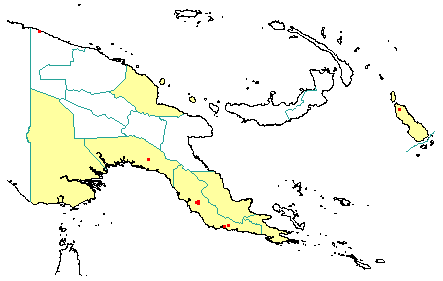
in PNGplants database
PNGTreesKey – Pterygota horsfieldii (R.Br.) Kosterm. |
Barry Conn (NSW) & Kipiro Damas (LAE).
Guide to trees of Papua New Guinea
Copyright held by the authors, National Herbarium of New South Wales, and Papua New Guinea National Herbarium
Reinwardtia Vol. 2: 365 (1953)
Family: Malvaceae
Dicotyledon
Timber Group: Non-timber species
Field Characters: Large canopy tree (up to c. 30 m high) or Small sub-canopy tree; Bole cylindrical (up to c. 100 cm diam.); straight (bole up to 20 m long); buttresses buttresses present; spines spines absent; aerial roots aerial roots absent; stilt roots stilt roots absent; Bark pale red, brown, or grey (pale mottled), smooth or slightly rough, slightly cracked; Subrhytidome (under-bark) yellow (pale (straw-coloured) or white; less than 25 mm thick; bark blaze consisting of one layer; faintly to non-aromatic; outer blaze yellow (pale (straw-coloured) or white, with stripes (pale brown); inner blaze yellow (pale (straw-coloured) or white, with stripes (pale brown); bark exudate (sap) absent; terminal buds not enclosed by leaves.
Indumentum: Complex hairs present, star-like (stellate); stinging hairs absent; mature twig indumentum (hairs) present when young or soon absent, hairs usually sparse.
Leaves: Leaves clustered at end of branches to spaced along branches, spiral (leaves occurring singly at a node and arranged spirally up the branchlet), simple (a leaf composed of a single blade); petiole present, not winged, attached to base of leaf blade, swollen (slightly (at base) to not swollen; leaves broadest below middle, 14.0-24.0 cm, 9.5-20.0 cm; symmetric, entire, not dissected or lobed, obtuse or sub acuminate, venation pinnate, secondary veins open, prominent, intramarginal veins absent; leaves lower surface green, upper surface dull dark green, indumentum (hairs) usually absent or occasionally present, indumentum (hairs) sparse; absent; domatia absent; stipules present, free, laterally placed, not encircling the twig, leafy, not fringed, large (c. 3 mm long), not persistent.
Flowers: Inflorescence axillary, on the trunk or branches, or sub terminal, flowers on a branched axis, cones absent; flowers unisexual, unisexual with male and female flowers on the same plant, stalked, flowers with many planes of symmetry, 12.0-15.0 mm long, diameter small (up to10 mm diam.) (c. 10 mm diam.); perianth present, with all sepals and/or petals (hence tepals) similar, inner perianth brown (pale (densely covered with reddish brown hairs) or dull red; 5, some or partly joined (forming almost subfleshy perianth tube and 5 lobes); stamens 25 (c. (in groups of 5 - male flowers; sterile anthers - females flowers), absent, joined (to form a staminal column), free of the perianth; ovary superior, carpels partially joined, by base, locules 5; styles absent.
Fruits: Infrutescence arranged on branched axis, fruit 70.0-80.0 mm long, 60.0-70.0 mm diam., brown or red, not spiny, non-fleshy, simple, dehiscent, follicle (opening by one slit); seeds 100, about 10 mm long (12-15 mm long, excluding wing) or much more than 10 mm long (c. 60 mm long, including wing), winged (with a single wing 40-45 mm long), broad (as wide as long) (slightly flattened), seed 1-10 mm diam. (c. 10 mm diam.).
Distribution: Madang, Western, Gulf, Central, Northern, Milne Bay & Bougainville.
 | Botanical records in PNGplants database |
Notes: Notes The genus Pterygota was previously classified in the family Sterculiaceae.